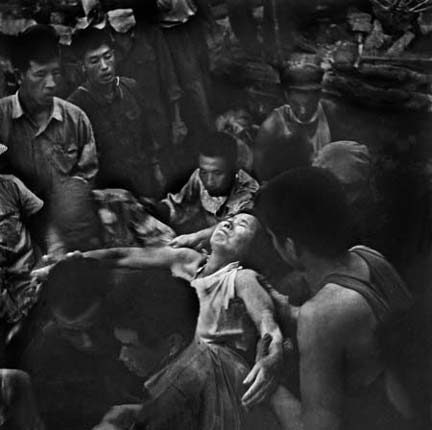China this week marks the 30th anniversary of the great Tangshan earthquake
that killed 240,000 people, with survivors still in mourning and the government
focusing on the rebuilding.
|

Lu
Guilan,trapped under the ruins for 13 days, was rescued by soldiers.
[Newsphoto/file]
|
The quake, the most deadly of the 20th century, measured 7.8 on the Richter
scale and shook the northern industrial city of Tangshan to its core for 15
seconds at 3:42 on the morning of July 28, 1976.
Many who were buried alive underneath the rubble of the earthquake were
killed 15 hours later when an aftershock measuring 7.1 struck.
Nearly a quarter of the then population of one million people in Tangshan,
about 200 kilometers (120 miles) east of Beijing, died in the quake and its
aftermath, according to official figures.
"The most horrible memory I have of the earthquake was walking through a
small area that was piled full of dead bodies in plastic bags," Li Xuemei, now a
book seller in Tangshan, told reporters.
"At the time, I was only seven years' old, so I don't remember a lot of
things, only that it was horrible."
Eight members of Li's family died on that day, including a younger brother,
three of her grandparents, an aunt and several cousins, she said.
"Things have really changed for the better in Tangshan over the last years,
but still on July 28 we will not be celebrating our survival, we will only
commemorate the dead," she said of Friday's anniversary when Chinese President
Hu Jintao is expected to visit the city.
The quake, which produced energy 400 times more powerful than the Hiroshima
atomic bomb, seriously injured over 160,000 people and destroyed 90 percent of
Tangshan's buildings.
The epicenter of the quake was located eight kilometers (five miles) directly
beneath Tangshan.
The disaster left 4,200 children under 16 orphaned, while 7,000 men lost
their wives and 8,000 women lost their husbands. Over 7,200 entire families
perished in the quake.
"It was a devastating day," said Wang Baoqin, 57, a woman who has survived to
sell souvenirs and photos at Tangshan's earthquake memorial.
"That morning all we did was search and search for people. I survived without
any injuries, but many in my family were killed or injured.
"I still clearly remember all the dust and flattened buildings, the screaming
and wailing for help."
Wang said that the changes that have taken place in Tangshan since the
earthquake were "unthinkable" 30 years ago, but still China's booming economic
development and modernization drive had not replaced the pain of the quake.
Railway worker Chen Jianhua, 50, said he will never forget being buried for
two hours beneath the rubble of a brick shed where he was living with other
workers at a construction site.
"Other workers noticed that no one came out of our shed, so they began
digging until they found us," Chen said.
After being rescued with only minor bruises, Chen walked home over 15
kilometers (nine miles) through the heart of the city, ignoring the screams of
the injured and the cries for help.
"Bodies were being piled everywhere, but I couldn't stop
to help because all I thought about was getting back home to see if my family
was all right," he said. He was relieved to find his mother and father alive, although he lost friends and other relatives.
For the 30th anniversary commemorations, media has largely focused on the
rebuilding of Tangshan into a modern-day metropolis of nearly three million
people full of new buildings and wide boulevards.
With thriving steel, other metals and coal mining industries, Tangshan is one
of China's top 50 cities with a gross domestic product of 54 billion yuan at the
end of 2005.
The city proper is surrounded by the Tangshan prefecture made up of six
districts, six counties and 7.14 million people.